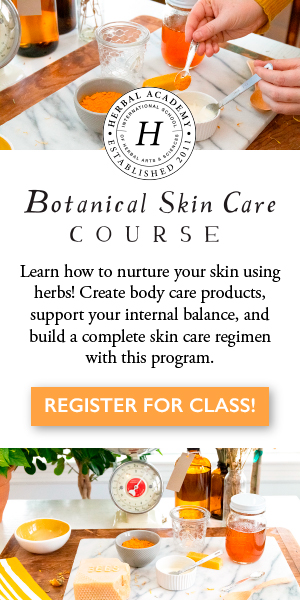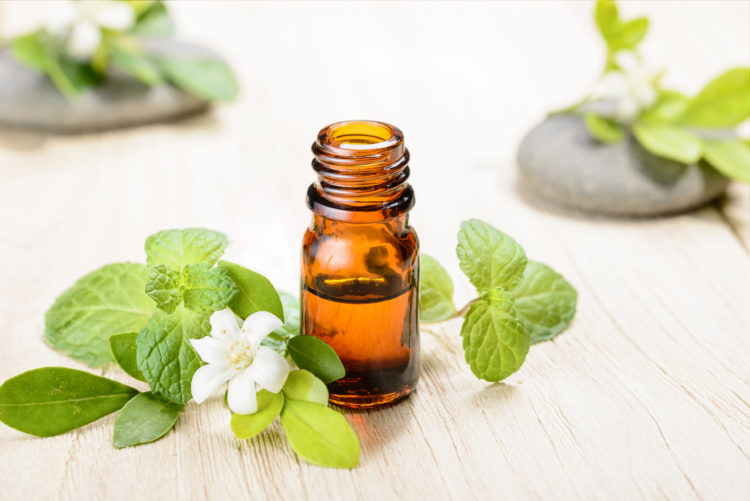
by Leslie Moldenauer | | Essential Oils
Essential oil safety is a hot topic, understandably so with its popularity. I have hit on many topics over the years and decided to share my top essential oil blogs of all time with you. Twenty topics that have been seen and shared thousands of times, in the ease of one place.
Essential Oil Safety…..There is often much debate about whether we can utilize aromatherapy in the birthing room, or during pregnancy at all. Is it safe? How do we do it? Let’s talk about what we need to consider- Utilizing Essential Oils During Labor and Delivery
The essential oils that we know, and love are derived from plants, but this does not necessarily mean that the therapeutic benefits or uses from the plant to essential oil are the same. In many cases, this does not hold true. There are many recipes online utilizing essential oils that do not honor chemistry and do not focus on safe use. Sustainability is also a massive concern as more and more people are stepping into the essential oil community every day. It is not necessary to use oils every day, or in everything. When we see a recipe shared online, we must ask ourselves if it is necessary, shifting the way we currently see these beautiful resources.
As women, “most” of us are not prepared for motherhood in the way I am about to discuss. Other than books and articles preparing us for Baby, such as the best-seller, “What To Expect When Expecting,” there is not much at all by way of truly preparing us moms for this huge life shift. I am speaking emotionally, mentally and physically. We can find information in books regarding cracked nipples, perineum tears, how long to wait before sex, stretch marks and hemorrhoids, but ladies; we need so much more than that!
Why Is It That Essential Oils Don’t Always Work? Does this topic surprise you? It is true, there are times that essential oils do not work as we think they should, and many instances where what works amazingly well for one individual does not for another. There are a few points that I want to make today on this topic, so let’s get started!
It becomes very challenging to know whom to believe when there are individuals and ‘health gurus’ claiming this to be factual, so I think it is important that I pull this myth apart. I have spent a great deal of time researching this topic. I will be simplifying and summarizing it for you today. It is time to put this idea to rest.
Drawing down a fever is not something that is recommended, as a fever is a sign that our immune system is working as it should be to help us get well. Rather than make my case for why you would or would not want to lower a fever, I want to cover the various ways in which we can work to make our kids a bit more comfortable while supporting their immune system to fight whatever germs are trying to take hold.
As someone that focuses on essential oil safety above all else, I tend to talk about why specific oils or methods of use are not safe. Today I want to shift focus to what essential oils are safe and look at them in a bit of detail. Empowering and helping are two words that are very important to me and my business…because if I do not support you to feel empowered to help your family, your children, and yourself..then what have I done? Fear is not where it’s at, so let us begin!
Confirmation bias is a propensity to search for or interpret information that we find in a way that confirms one’s preconceptions. In other words, when performing research online or at the library or other learning institutions, the individual doing the research has already made their decision about the topic before they have begun their search. Rather than looking to find “the truth” so to speak, they are looking for information that agrees with what they already think!
Aromatherapists have written articles about the safety of the constituent 1,8 cineole, specifically Eucalyptus radiata, Eucalyptus globulus, and Eucalyptus smithii. You’ll read plenty of articles as to why this constituent is not safe for children and not to use it at all under the age of 10. This is not, however, an accurate statement.
There are times where we all fall suspect to confirmation bias when it comes to what we are told in regard to natural remedies. We may know that there are indeed specific benefits to a remedy, we may have even experienced a few of them firsthand, but those benefits can oftentimes be extrapolated beyond what is scientifically shown. Do Epsom salts really work?
The variety of choices for a holistic first aid kit is quite exciting for the DIY’er in you and goes well beyond essential oils. Just about anything can be handled well with holistic remedies, and there are a plethora of options. I will be going over a few of those options today. If we have the choice of handling things at home and not have to travel to a doctor’s office where there is oftentimes a myriad of germs, let’s give it a go, right? I think it is important to understand when getting medical care is needed, but it is not always needed.
There have been many blogs stating that essential oils are great for our gut health and that they provide us with a healthy microbiome. The issue with statements like these is that people walk away from reading these articles thinking that essential oils work much like a prebiotic or probiotic….when that has yet to be proven. With an education in Aromatic Medicine, I can see how these statements or claims are somewhat like a telephone game. My goal is to help you see what I mean by that. Let’s take a look at our gut health…one of my favorite topics, and how essential oils can play a role. It’s not what you think!
This article will be speaking to aromatherapy use during pregnancy and beyond into the nursing years. I decided to write about this because there are a lot of misconceptions out there. Pregnancy is a delicate time, especially during the first trimester, and as we know that chemical constituents in essential oils pass the placenta, even though only in minute amounts, so safety needs to be addressed.
Is witch hazel an emulsifier? Is witch hazel a preservative? Discover its uses and limitations.
Children are much more sensitive to essential oils and aromas in general, but they can also benefit greatly from their therapeutic uses. There are a number of things that parents need to know before using them to ensure the safety of their children. Looking up a blend or recipe online is not the best way to use your oils. Let’s cover a few things that you may or may not already know in order to keep your little ones safe.
I felt that it was important to address this topic in more detail as it is shared so easily without much understanding of the safety issues involved. It is recommended to avoid fennel essential oil during pregnancy and lactation, and utilize caution with the herb in levels more than what would typically be consumed in food. Congratulations to all mom’s out there embarking on a beautiful time with your new little bundle of joy.
What is an adverse reaction to an essential oil? Would you know what to do if you or your child had an adverse reaction to an essential oil or oil blend? Do you know what an adverse reaction looks like? I will be covering a few of those here in hopes to make you more aware of what that might look like, and what to do if it happens. When we use essential oils, safety has to be the first thing we keep in mind.
Just as you would (or should) exercise caution and research when using pharmaceuticals, you should practice the same careful research when using essential oils. Essential oils are profoundly powerful, which makes them capable of powerful healing, but also injury when used improperly. Overuse and misuse can and do lead to injury.
Proper use of essential oils in the bath. Not only are the specific oils used in the bath of great importance, but safety also needs to be considered in how you add them as well. For example, use peppermint with great caution as it can be a very “eye-opening” experience, and bergamot is a very strong photosensitizing oil, the bath is simply not the “best” place for its use.
The risks of diffusing essential oils in the classroom. If we take into consideration the number of germs that are passed back and forth at school, it is not a surprise that some teachers have considered diffusing essential oils in the classroom. For those with minimal education, this may seem like a great solution to keeping sickness at bay and to keep attendance up, but it comes with a significant amount of risk. Many are told that essential oils are completely natural and safe for everyone, but this is not always the case. There are many things that need to be considered when diffusing in a classroom full of children with a variety of different health constitutions. The liability in this type of situation needs to be looked at closely.
I hope you enjoy my top essential oil blogs of all time. Stay tuned as I share the latest findings and most recent research with you!
Get your copy today!


Like so many practices in life, I encourage you to become educated on the proper use of essential oils. When using them, please do so cautiously, understanding that there is often misinformation on the internet. You can be assured that I support only educated and proven resources. While essential oils should not be feared they should be respected and used properly to ensure the safety of the individuals using them.
Please note that I am not a medical practitioner. The content of this website is provided for general informational purposes only and is not intended as, nor should it be considered a substitute for, professional medical advice. Do not use the information on this website for diagnosing or treating any medical or health condition. If you have or suspect you have a medical problem, promptly contact your professional healthcare provider. By using this website, you assume full responsibility and liability for your own actions.
3 Common Yet Risky Essential Oil Mistakes
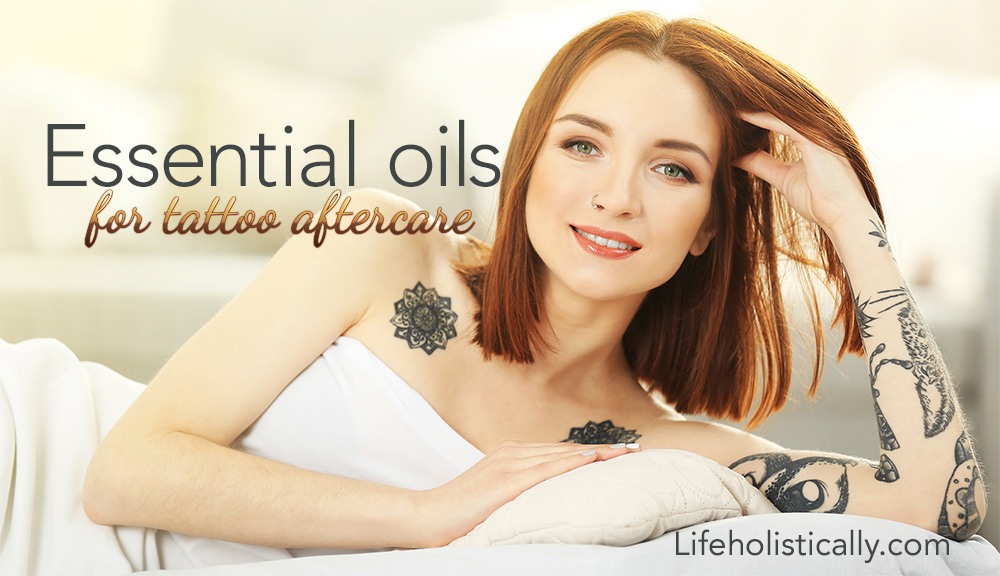
by Leslie Moldenauer | | Essential Oils
The tradition of tattoos has been around for thousands of years, and in the last couple of decades has really been accepted as mainstream. A Harris poll in 2012 found that 1 out of every 5 adults (21%) has at least one tattoo, and those numbers are significantly higher today [1]. Tattoos are a form of self-expression, enabling the body to become a canvas of sorts, a work of art.
Tattoo aftercare is important to avoid possible infection. Although it is rare, it does happen, oftentimes from improper aftercare or issues with the ink itself. One should not simply grab a lotion off the store shelf, or utilize a petroleum-based product.
After an individual gets a tattoo, they are sent home with aftercare instructions that include making sure the tattoo has room to breathe, keeping the area clean and moisturized at all times, using only the product that the artist recommends, avoid sun and chlorine and various other pieces of important instructions.
Unfortunately, over the years, individuals have used said petroleum-based products, which can trap dirt and germs and can be the exact cause of the infection that new tattoo owners are trying to avoid.
Can we utilize herbal and essential oil concoctions to not only heal a tattoo faster but also help to retain color vibrancy and skin integrity? Quality information regarding utilizing botanically based products as a part of skin care after a tattoo is not talked about often, therefore I thought it was very important to reach out to others in the community to find out its history. Professional experience speaks volumes to its safety and effectiveness.
I was honored to find two brilliant practitioners with years of the exact experience we need to have a clear picture. They are both very excited to share with all of us their findings.
For those that are not familiar with you or your work, can you introduce yourself and tell everyone a little bit about what you do?
Hello! I am Vivienne Campbell and am an herbalist. I’ve worked here in Ireland since I qualified 15 years ago. I run a clinic, teach herbal medicine, wild food foraging, and natural cosmetic-making. I also teach these world-wide via my online video course. Over the years I’ve formulated and produced professional natural skin care products for retail for myself and other brands. I also work very closely with clinical aromatherapists. I gave a lecture at the first ever Botanica conference back in 2012 and have been involved with them ever since. I have also interviewed with the producers of the upcoming aromatherapy documentary. They filmed one of my herb walks and interviewed me about herbs, essential oils and sustainability issues (I’m passionate about organics and sustainability issues, having taught classes at an organic seed bank since 2004). There’s heaps of info on my website, The Herbal Hub.

My name is Gillian Parkinson, I live in Roxburgh, Central Otago, New Zealand. My love for essential oils began about 25 years ago, in 2009 I decided to make it official and began my official studies with AromaFlex, studying Cert. Aromascience, this was a 770+ course which I absolutely loved. I graduated end of 2010.
My company Le’Esscience was born, I have a private practice where I provide a massage service, consultation & blending essential oil products. I also have 2 online stores where I make products and ship them worldwide.
I have a few stand out products (all developed by me, I have huge ethics and will not copy anyone’s recipes), to name three, Puppps Relief (a blend that assists in relieving symptoms for a distressing pregnancy rash), MendBlend, first aid blend and TINKture Tattoo Aftercare.

I wanted to talk a little bit today about utilizing essential oils topically for tattoo aftercare. There is not much by way of research or documentation regarding using essential oils in this manner. What is your experience here?
V.C.-Like some of the best things in life, I got into treating this by accident! I don’t have any tattoos but one of my patients was really into them and back in 2004 he asked me to try to make an aftercare product. I met his tattoo artist and he showed me what they used and asked me to try to make something similar. He was buying a natural ointment from the USA, but back then not much was known about tattoo aftercare and most tattoo artists were telling their clients to apply Preparation H, a hemorrhoid cream! I explained to them that this would be more likely to slow down healing rather than help it to happen.
I made a gentle natural ointment using carrier oils and herbal infused oils that traditionally help the skin to heal and prevent scarring. I also included some essential oils to add antiseptic properties to try to prevent infection and to give the product an appealing fragrance. I used rosemary, lavender, frankincense, and sandalwood (it just goes to show how long ago this was: it was before I learned about the sustainability issues of using sandalwood oil).
G.P.- I have around 8 years’ experience in this particular field now, being heavily tattooed myself, I’ve worked in the industry since I developed TINKture.
I decided to develop a tattoo aftercare product to use personally due to the lack of a product that actually aided and sped the healing process, I bruise like a plum and swell so I wanted something to help with that as well so I made my own back in 2010. My tattoo artist was so impressed he said I had to do something with it, so I requested around 20 testers, feedback was incredible, and there were no negative reactions so 6 months later I put it to market. TINKture has a real point of difference due to the fact it actually aids and speeds the healing process, it doesn’t just soothe the area, it has analgesic, anti-inflammatory, antiseptic properties and assist with the itchy stage too.
I can also help (along with antihistamine support) when someone has an allergic reaction to ink, I have experienced this and it is unpleasant and can be very painful. I have great hints and tips to get through this stage, still using TINKture as well as antihistamines and covering and washing for 7-10 days.
I have sold thousands of bottles now, and the feedback has been incredible.
Some individuals are really unsure if this is a safe practice. Why are you confident in employing them in this manner? Have you ever received any negative feedback?
V.C-Well firstly, I was asked by the tattoo artists to do this. It was their idea, not mine so I wasn’t going into it blindly. The confidence came from their feedback. The artists loved the product because they found that it preserved the colours and lines of their artwork much better than other products or no aftercare at all. If the skin doesn’t heal properly then this impacts on the artwork so well-healed skin=a better-looking tattoo and that is better for the tattoo artist (the artists I worked with won several awards). Over the years that I made this for them (6 years), I made thousands of jars of this ointment. Yes, some people had reactions to it but that is to be expected when you are dealing with numbers this high. Occasionally someone would be allergic to one of the ingredients. The recommendation would be to wash it off immediately and go back to their tattoo artist for alternative care advice. The tattoo artists were very helpful in these situations: some of their customers were allergic to the ink too! It just has to be dealt with sensibly.
When it comes to applying aftercare, less is more. A thin layer of ointment applied regularly is the thing that we found worked best for skin healing, rather than slathering on a huge amount and stopping the skin from being able to breathe. The tattoo has to be gently washed before each application of ointment. If people don’t do this then they can trap germs, it gets infected and ultimately this is more work for the tattoo artist because the tattoo gets damaged when the skin doesn’t heal properly and they need to spend additional time doing repair work on the tattoo.
The tattoo artists loved this product because when people used it their work looked better, the colours were brighter, the tattoos lasted in peak condition for longer and it reduced the number of time (unpaid hours) that they had to spend fixing work that had been damaged by insufficient aftercare treatment.
G.P.- It is safe if it is made correctly, using essential oils suitable for wound healing, don’t have contraindications (pregnancy, health conditions etc) the correct dilution, the appropriate carrier oils, directions are followed and storage and shelf life is respected.
I haven’t had ‘negative’ feedback per say, I have had people confuse reactions to allergies to ink, I’m so schooled on this subject and can tell the difference. I help any customer by asking them to send me photos of what’s happening, usually, once I see the photo, I can tell what’s going on. Inks have improved over the years, but there are still artists that ‘cut their own ink’ and use things like liquid soap, mouthwash, witch hazel, propylene glycol to cut ink, also some inks have metals in them, so mostly, it’s these ingredients that people react to. TINKture can help with settling the symptoms.
I can honestly say, I have never been told of an actual allergic reaction, it is rare if someone isn’t already sensitized to essential oils (due to incorrect or overuse) and the product has been blended correctly.
Below is a review from one of my stockiest – I didn’t request this, he just wrote it unprompted
“As a tattoo studio owner and after tattooing for over 10 years now I can honestly say this is the best product I have come across for healing tattoos. I have tried many over the years with varying results and my wife and I agree, this is the product we will be stocking and recommending to our clients. We have used it and stocked it for some time now. We were so impressed with both the product and the lovely people behind it that my wife wanted to model for the promo. So she did. That’s my beautiful wife in the poster. That’s how much we believe in the product. Check it out for yourself.”
Lampin
Lampin Ink
I assume this is not a one size fits all situation. Is there anything that you want to include on the topic? Are there specific oils that we should stay away from? What would you like everyone reading this to know regarding essential oils and tattoo aftercare?
V.C-Absolutely. No ingredient (natural or synthetic) suits everyone in the world and there will always be someone who will react to something, no matter how gentle the ingredients. Don’t panic if this happens, just wash it off and don’t use a product containing that ingredient again.
*Make something gentle. It’s not a disease or a massive infection that you are trying to treat.
*Use a very low percentage of essential oils: this product doesn’t need to be strong.
*Use fixed and herbal infused oils that are gentle.
*Avoid calendula infused oil: I know it’s recommended for skin healing but it seems to irritate and aggravate skin conditions in about 1 in ten people from what I’ve seen. It can heat up a wound and worsen it. A tattoo artist from the Netherlands that I worked with found this too and used to avoid natural aftercare products containing this oil.
*Legal work for retailing this product: depending on which country you are in, you may need to do some lab work to get it tested and approved as a retail cosmetic product. This is certainly the case now in EU countries. However, don’t worry about this. Products made from oils, butter and waxes (i.e. water-free products) are straightforward and relatively inexpensive to get tested and assessed by a cosmetic chemist. Depending on which country you are in and the rules there, you’ll need this work done so that you are insured for making this as a legal retail product. If you simply want to make some for some clients who attend your aromatherapy clinic then you shouldn’t need to do this because it should be covered like any other treatment you do there.
Thanks for asking me to talk about this. I made this product for tattoo artists in Ireland for years until the recession here got very bad and some of the studios started to close down. It was a beautiful product to make (it smelled fantastic!), I had great fun doing all the graphic design work for it, taking photos of the tattoos and collecting testimonials. I think you’ve given me the nudge I needed to start making it again so watch this space!
G.P.- I think THE most important factor is to find out if the essential oil aftercare (well any aftercare actually) you are using (which doesn’t come from a large manufacturer ie nappy rash creams, which I don’t recommend using) has been developed and made by someone with professional qualifications in that field, this is VITAL as unqualified people will not understand adverse reactions, contraindications :ie using beeswax or sweet almond oils, useless & potentially dangerous for anyone with bee or nut allergies, essential oil safety, the actual active properties of the ingredients, if it’s safe if it gets in the wrong hands (a child, pregnant woman etc). This includes people who just google, hobbyists, tattoo artists even, resellers of products that may be suitable to use but have no official experience in blending or understand the process of wound healing. If you are unsure, ask questions – the qualified practitioner will not hesitate in reassuring you.
I would never use peppermint, tea tree, rosemary specifically but importantly, essential oils that are not suitable for wound healing – and nothing more than 2-3% dilution.
It truly also helps, if the person making the products, yes, has the qualifications, but is also tattooed, in many places! – I have learned SO much about how different areas heal differently, healing tattoos in the summer is different from healing tattoos in the winter, certain fabrics irritate healing ink, the weather, your health too, if you are sick, you should not get tattooed, if you do, expect it to take longer to heal, if you have a health condition, such as fibromyalgia, expect your ink to take longer to heal – I developed TINKture with all these variables in mind, making it a safe, reliable and extremely effective natural (& vegan) product to aid & speed the healing process.
It all counts!
I would like to thank Vivienne and Gillian for sharing their expertise with us. Understanding the years of training and wisdom that are behind formulating essential oils for tattoo aftercare helps us tremendously.
There is an inherent risk of applying a product not recommended by a professional versed in skin care formulating. Both of these amazing professionals make a product very specific to the tattooed skin based on a lot of education and experience. I would discourage a home user from attempting to blindly blend something for their own use or seeking advice from a Pinterest image. Please seek advice from someone with significant knowledge on the subject.

Reference
[1] http://www.pewsocialtrends.org/2010/02/24/millennials-confident-connected-open-to-change/
BEFORE YOU GO! Remember to sign up for my FREE Facebook group! Hang out with me and THOUSANDS of other Essential Oil lovers looking to learn, click on to join Real Essential Oil Education Group!
Check out my FREE offer below!
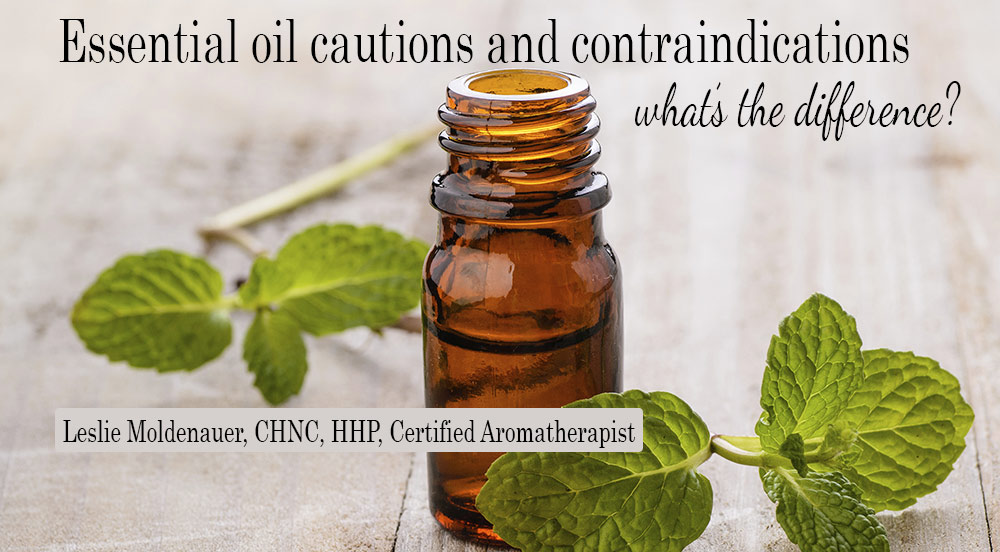
by Leslie Moldenauer | | Essential Oils
Essential Oil Safety-Cautions and Contraindications. This post is in response to a need/request from a poll in my Facebook group “Real Essential Oil Education Group”. The members asked for clarification about the differences between essential oil cautions and contraindications.
I had received an email back in April of 2017, asking me to state what I thought a caution and a contraindication meant in the aroma world.
He wanted to know what I thought the differences were. I am not sure if he thought I did not know (chuckle) or if he wanted to be sure I did. Those two things may seem similar, but I assure you at the moment they were very different considering the nature of the inquiry. This was my exact response, copy and paste from my response to him:
“Of course, happy to share my thoughts….
A contraindication is a situation, which makes a particular essential oil absolutely inadvisable. Of course, we know in “most”, but not all cases these contraindications are indicated via the oral pathway.
A caution or precaution is relating to an action taken to protect against possible harm/adverse effect if you will, in this case, avoid dermally under age two. In my practice, these would be more of a case-by-case basis, as sometimes the benefit does outweigh the risk. But this is not something I teach or share online for obvious reasons.
I would hope this is how most in the field understand it, but I am being generous. A quick Google search (my favorite) shows these two terms more often than not are interchangeable”.
This is the beginning of the issue I am afraid. Good Ol’ Dr. Google. A pervasive problem in so many areas, I actually wrote a blog specifically on that topic. But I digress.
When looking up the differences between a caution and a contraindication, even Google seems rather confused (said jokingly), people are confused. So, I thought I would go over it just a bit for you today.
These two terms should not be used interchangeably when it comes to essential oils just as much as herbs or pharmaceuticals.
*All examples below are from the book, Essential Oil Safety 2e written by Robert Tisserand and Rodney Young. (Get your copy here). None of the cautions or contraindications listed within is my own finding. My goal to close the gap on the many misunderstandings.
The book states that cautions are:
“potential hazards that do not warrant contraindications, either because the evidence is flimsy of because the hazard is not especially worrying”[1].
Cautions
Hypersensitive skin
Under age 2
Old/Oxidized oils should be avoided
(oral) Drugs metabolized by a particular cytochrome P450 pathway
(oral) Pregnancy
(oral) Specific medication
(oral) Peptic ulcer
(oral) GERD
(oral) Major surgery
This is not an all-inclusive list, but there are a few things to point out.
If this is a listed caution, it is ‘possible’ that there could be an issue when used in this manner.
- For example, you could utilize an essential oil that is listed as a caution under the age of 2, like lemongrass (Cymbopogon flexuosus), for example. Is it off limits? No. Should we be educated and know the risk, and work to minimize risk? Absolutely.
- Another example would be (oral) GERD, as is the case with Peppermint (Mentha piperita) essential oil. Can you take peppermint in this manner? You can. Is there an increased likelihood to have gastroesophageal irritation and heartburn from it? There is. But, if taken responsibly, such as in an enteric coated capsule over something not recommended like dropping peppermint essential oil in water and drinking it, will go a long way in reducing the risk from said caution.
- Old/oxidized oils should be avoided. It can be challenging to determine if an essential oil has oxidized. If you apply an oxidized essential oil properly diluted to the skin, you ‘may’ have a reaction…and you may not. This is not a statement to encourage you to do this, it is just stating that it should be avoided if at all possible to eliminate the risk from said caution.If we can eliminate risk, we should right? But, reality check…..in aromatherapy, there is a risk. Some small, some not so small….and it is an aromatherapists job to first and foremost be able to analyze any risk…and look for ways to lower it. Eliminating it all together is in many cases not possible. Now let’s look at contraindications.
The book further states that contraindications are:
“When the oil should be avoided. The method of administration is also stated. Oral contraindications apply to the oral of administration of essential oils as used in aromatic medicine. Oral contraindications do not apply to the use of essential oils and any other context, such as in foods, fragrances, personal care products or by inhalation” [2].
Contraindications
(all routes) Do not apply on or near the face of infants or children
(all routes) Anticoagulant medication
(all routes) Pregnancy
(all routes) Children
(all routes) Estrogen-dependent cancers
(oral) Cholestasis
- The first example here with contraindications is a popular one, and that is an essential oil high in 1,8 cineole should be avoided (is contraindicated) on or near the face of infants and children. This does not mean no, never, it means never near the face. Responsible diffusion may be perfectly ok.
- Pregnancy contraindications, when listed as (all routes). The benefit does not outweigh the risk, it should be avoided for all routes of application: topical, inhalation, or oral, period.
A couple of important points to remember:
*If a contraindication states (oral) in the book, this does not mean that the oil needs to be avoided topically or via inhalation.
*Remember, cautions are a ‘potential chance’ of an issue. There are many essential oils that are cautioned under the age of 2 dermally/topically. This does not then mean it cannot be inhaled.
Some may see this information as cut and dry, while others still need further clarification. There is nothing wrong with being overly cautious, and many professionals are. We all come to the table with varying levels of experience so this is expected.
If I ever find myself in a position where I am taking a caution a step further than Tisserands recommends I typically say “The research states X, but in your situation, I am not comfortable making that recommendation because of Y”. I try to always stay true to what we do know, not make my own rules, but I am willing to step outside of the box when my education and experience tells me the situation warrants it.
I am a stickler about using the verbiage above in order to not cause confusion on what we do know about cautions, contraindication, and hazards….and explain things as thoroughly as I can.
I hope that this helps to clear up any possible confusion that a ‘caution’ often brings up. If you need further clarification, I invite you to reach out to me in the group (request to join), or simply email me at Lifeholistically@gmail.com
References
[1] [2] Tisserand, R., Young, R., & Williamson, E. M. (2014). Essential oil safety: A guide for health care professionals. Edinburgh: Churchill Livingstone/Elsevier.
Like so many practices in life, I encourage you to become educated on the proper use of essential oils. When using them, please do so cautiously, understanding that there is often misinformation on the internet. You can be assured that I support only educated and proven resources. While essential oils should not be feared they should be respected and used properly to ensure the safety of the individuals using them.
Please note that I am not a medical practitioner. The content of this website is provided for general informational purposes only and is not intended as, nor should it be considered a substitute for, professional medical advice. Do not use the information on this website for diagnosing or treating any medical or health condition. If you have or suspect you have a medical problem, promptly contact your professional healthcare provider. By using this website, you assume full responsibility and liability for your own actions.
What is an Adverse Reaction to an Essential Oil?
Find Your Footing Using Natural Remedies
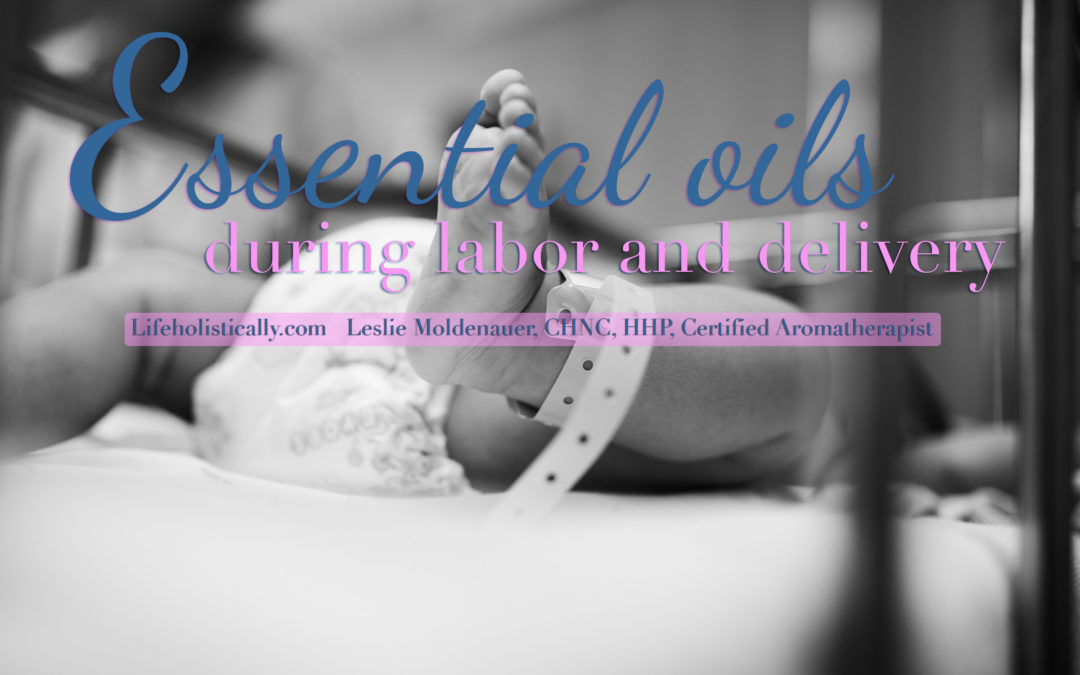
by Leslie Moldenauer | | Essential Oils
Essential Oil Safety…..There is often much debate about whether we can utilize aromatherapy in the birthing room, or during pregnancy at all. Is it safe? How do we do it? Let’s talk about what we need to consider- Utilizing Essential Oils During Labor and Delivery
If this is not your first pregnancy this should come as no surprise; your sense of smell is very heightened during this time. Smells that never bothered you before may now make you incredibly nauseous or even vomit. Perhaps an aroma you loved prior to pregnancy you do not like at all now. The opposite can also be true. Now, perhaps a new food has appeal simply because of its smell. You may even find that your partner smells better than ever! Enjoy that!
What causes this heightened sense of smell?
“The plasma volume (blood flow) in your body increases by up to 50 percent in pregnancy, so anything moving from your blood to your brain reaches it faster and in larger quantities. This heightens your responses and some experts think that’s why you react more strongly to smells,” says midwifery teacher Denyse Kirkby, author of, “My Mini Midwife” [1]. So, in theory, your olfactory receptors are also strongly affected by this increased blood flow.
Could this be another miracle of the body? Perhaps this is a protective mechanism to prohibit mom and fetus from inhaling anything potentially harmful? I would like to think that this is the case.
If you intend to utilize essential oils in the birthing room, you need to keep your heightened sense of smell in mind. The state of your body during labor also needs to be a part of the equation, as it and you will be in a heightened state of stress.
If you are unsure of what to choose, reach out to someone well versed in the use of essential oils during this sensitive time. If you do not have any major medical issues or are not taking any medication, aromatherapy is likely very safe. A trained aromatherapist will be happy to assist you to be sure.
Aromatherapy inhalers are my suggestion for the birthing room. I do not recommend filling the room with an essential oil blend via a diffuser for a number of reasons. First and foremost, your needs and wants will change, a lot. You will likely want to be as relaxed as you can be during increasing contractions up until it is time to push, then you will benefit from something to empower and awaken you while staying centered and focused. Those require different things.
Second, even though this is your experience with your partner, exposing everyone in the room to your diffuser blend is not a good idea. Public diffusing can be precarious. You do not know what other’s situations are in regard to health conditions, allergies or medications, and I do not know about you, but I would want my doctor, doula, midwife, and nurses to be alert, not enjoying a calming and sedating blend of essential oils, so please avoid direct diffusion in the birthing room.
I have been asked if there is anything that can be used to move labor along. What I consider moving labor along is not the same as how the question is usually intended. You can use essential oils to keep yourself calm, to keep the body from tensing and being overly-stressed, and by doing this, labor progresses nicely. The goal of essential oils should not be to induce or increase the intensity of your contractions or move labor along. This is not recommended. I have the same opinion of Pitocin. If this medication can be avoided, avoid it. Pitocin can cause problems such as intensified rapid contractions, so intense that both baby and mom can potentially become very distressed, increasing the need for medical interventions. I do understand that sometimes things are out of your control; so, do not beat yourself up about the way things progress in the delivery room. However, if you are able to pull it off, a natural birth is ideal.
Clary sage (Salvia sclarea) is an essential oil that is touted for starting labor. Unless you are working with a qualified clinical aromatherapist, do not use essential oils with this intention. Please let your body do what it knows to do, in its time. This does not mean, however, that clary sage needs to stay out of the birthing room.
Once labor is underway and contractions are regular, clary sage can be used safely in an inhaler to calm, with little potential for harm. I hope you can now differentiate between timing and wanted outcome.
You will find varying opinions on the Internet and in social media regarding whether essential oils are safe during pregnancy, labor, and delivery. Be sure to question the training and experience of anyone who has written a book or blog on a serious topic such as this. Aromatherapy and the use of essential oils are not regulated in the United States, so a license or degree is not required to give you and your family advice. During this special time of your life and the birth of your child, you will want to consult with a well-trained and qualified aromatherapist.
According to Jane Buckle Ph.D., RN, who is a very well respected aromatherapist, and founder of the American Holistic Nurses Association, aromatherapy is in fact very safe when you are well-versed in its safety and use. According to Buckle, aromatherapy has been used for years in a clinical setting without known harm to mom, infant or fetus [2]. Buckle has taught nurses all over the world how to safely use essential oils in their clinical practice.
I can’t stress this enough, do not pick up a random book or blog on essential oils for the birthing room. If you are unsure and would really like to explore the possibilities of using aromatherapy for you and your family, please reach out to a qualified aromatherapist.
Enjoy this FREE PDF download
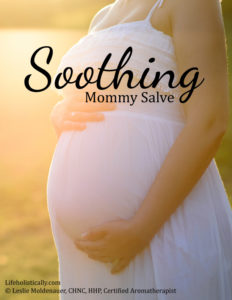 Click me >> Mommysalve
Click me >> Mommysalve
References
[9] Kirkby, D. (2014). My mini midwife: everything you need to know about pregnancy and birth. Chichester, West Sussex: Vie.
[10] Tillett, J., Ames, D. (2010) The uses of aromatherapy in women’s health. Journal of Perinatal & Neonatal Nursing. Vol. 24, No. 3, (pp. 238-245)
Resources
Postpartum Depression..The Importance of Asking for Help
Please note that I am not a medical practitioner. The content of this website is provided for general informational purposes only and is not intended as, nor should it be considered a substitute for, professional medical advice. Do not use the information on this website for diagnosing or treating any medical or health condition. If you have or suspect you have a medical problem, promptly contact your professional healthcare provider. By using this website, you assume full responsibility and liability for your own actions.
Essential Oil Safety for You and Your Family

by Leslie Moldenauer | | Essential Oils, Uncategorized
Essential Oil Basics-Uncovering Myths Versus Facts. You will be able to find a plethora of articles on the internet regarding essential oils, consequently, there are many myths surrounding them. This article will speak to some of those and provide links when appropriate for further reading.

The widespread marketing of two popular brands of essential oils has introduced many people to these powerful tools for health which is a real blessing. With it comes a few concerns. The first being the unsafe recommendations for use that is seen on blogs, Pinterest, as well as Facebook pages. Essential oils are not to be used carelessly, and misuse can lead to injury. The second is sustainability. So many are of the vein of ‘buy all of the oils’, and that can be really problematic for the future of our precious oils.
Just as you would (or should) exercise caution and research when using pharmaceuticals, you should practice the same careful research when using essential oils. Essential oils are profoundly powerful, which makes them capable of powerful healing, but also injury when used improperly. Overuse and misuse can and does lead to injury. Many have jumped in with both feet without fully exhausting the scientific research (not biased blog posts), then only after beginning their journey find out what they thought was true may not be accurate at all.
Believe what you like, but do not believe everything without questioning it. –Pauline Baynes

So what are essential oils???
Very briefly, essential oils are derived from the various parts of a plant (leaves, stems, flowers, bark, and roots), most often by steam distillation. Essential oils are the true essence of the plant (not the lifeblood of the plant) and are highly concentrated extracts. The chemical composition and aroma of essential oils provide many therapeutic benefits. Most benefits are achieved through methods including inhalation and application of the diluted oil to the skin, but also internally for those trained in aromatic medicine.
Essential oils are not the same as perfume or fragrance oils. Perfume oils are artificially created fragrances and contain artificial substances that do not contain any therapeutic benefit like essential oils do.
Essential oil dilution
Essential oils are very concentrated extracts, much more concentrated than the plant material that it is derived from. Since they are so concentrated, they need to be diluted before they are safe to apply to the skin.
When used undiluted or what some call “neat” there are two risks involved:
1-Irritation which is a direct result of contact with a material and is localized. Healing occurs once the material is removed. Removal is best with a carrier oil (almond, jojoba, etc.) or milk. Follow up with warm soapy water, then add more carrier oil if needed. Healing may not occur immediately, but you should see and feel improvement after proper removal.
2-Sensitization which is a systemic response involving the immune system. According to Dorene Petersen, president of the American College of Healthcare Sciences (ACHS):
“Sensitization occurs once the offending substance has penetrated the skin, been picked up by proteins in the skin, and mediated by the IgE response that produces histamine and other irritants” [1].
This is an allergic reaction. Some oils are more likely than others to elicit this sensitization response, such as lemongrass and cinnamon bark….but it can happen even with oils that some consider gentler oils such as lavender and peppermint. Once this immune system response is triggered, that may mean you can never use that oil again. Never! Compare this to a nut allergy. Not worth the risk!
Please do not subscribe to the “detoxing” explanation where skin irritation is concerned, this is simply not true. If you get a rash or a burn from putting something on your skin is it because it is irritating your skin. Unfortunately, the detox reaction is still being shared as a viable explanation for a rash, and innocent people are being injured. Sometimes by applying more essential oils to the irritated area. Please hear me when I say, skin irritation that can result from essential oils is NOT a detox reaction at all. There is good news in all of this though, and that is when you properly dilute your essential oils, the risk of any irritation is greatly reduced.
Check here for a detailed explanation on this topic from my friend and colleague Liz Fulcher, owner of the Aromatic Wisdom Institute.
Oil and Water
Essential oils are not water soluble. Oil and water do not mix/blend. They need a disbursing agent before adding to your bath water (carrier oil); Epsom salts alone is not enough.
Please do not add essential oils to a glass of water and drink it.
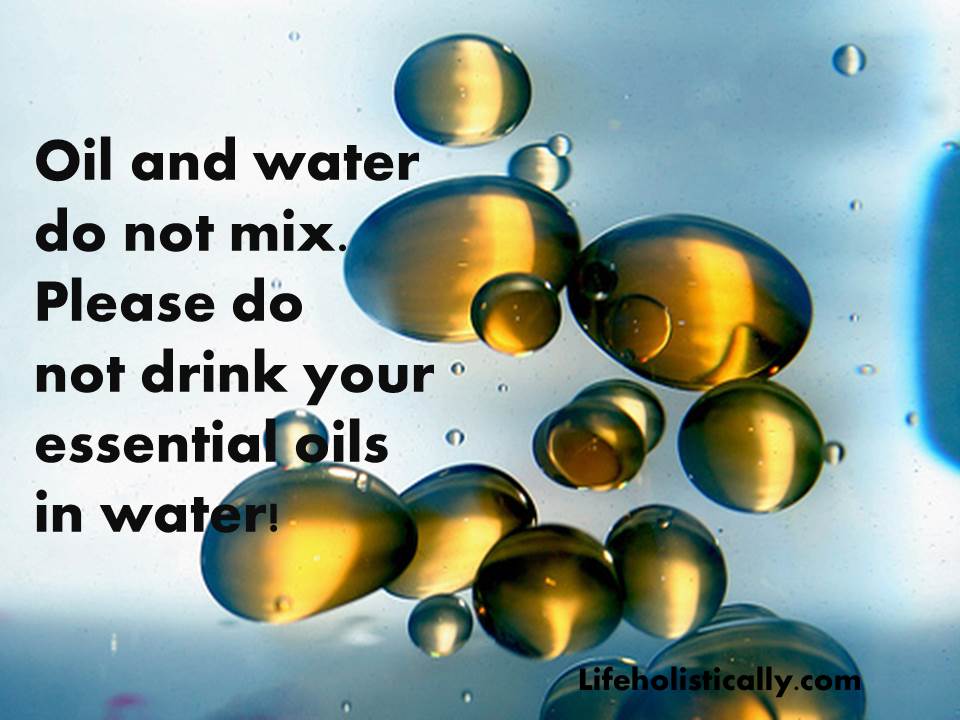
When you add a drop of oil to a glass of water it doesn’t mix with the water. The risks are not worth the practice. Oral dosing may interfere with medication or aggravate other medical conditions. Please refer to the 2014 book, Essential Oil 2e by Robert Tisserand and Robert Young to learn which essential oils carry the most risk internally when taking daily medication.
You may hear something like “our oils are pure therapeutic grade and are safe for internal use” or “certain oils are GRAS” (generally recognized as safe for consumption), but this applies to consuming in food (food additives); not in water. Follow the link here for an informative article by my friend and colleague, The English Aromatherapist about what GRAS really means.
Essential oils can be safe for internal use under certain circumstances when under the care of a professional; someone who has been trained, ultimately much more than the basic 200 hour foundation training, and has to understand how these oils react inside the body, if it is necessary for your condition, and most of all if it is safe and indicated for you and your situation (medication, medical conditions, allergies, etc.). Look for someone such as myself who has been trained in aromatic medicine. Not all aromatherapists have this level of training.
More on Internal Use…
Internal use is not meant to be an everyday practice. It is not to lose weight, ease indigestion, or to be used as a preventative measure to maintain health. That is where healthy eating, exercise, sleep, vitamins, and minerals come into play when you are deficient. Essential oils have no “nutritional value”; another myth. Read more on these topics here and here.
Inhalation
By far the most common method for using essential oils is via inhalation.
Inhalation is THE QUICKEST route to the bloodstream. You can achieve this by using an aromastick, using a diffuser, using a steam bowl, or spritzing into the air to name a few.
Topical Use
When used topically (on the skin), in a suitable dilution, essential oils have a multitude of applications for health, beauty, and well-being. Methods include massage, skin care, and first aid remedies. Essential oils can be added to many personal care products. Applying to the skin also induces inhalation, therefore benefiting multiple systems of the body at the same time.
There are a number of oils that cause photosensitivity or phototoxicity. This can occur when certain essential oil constituents react when exposed to ultraviolet light. This includes the sun as well as tanning beds. Inflammation, blistering, and burning of the skin are possible. These particular oils can be used on the skin, but use caution. It is advised to not go out into the sun or lie in a tanning bed for 12-24 hours after exposure to the specific essential oils. Just to be clear, this applies to the specific areas of skin that have been exposed to the oil, not your body as a whole.
Here is a list of oils that should be used topically with caution, and their maximum use levels when blended according to IFRA standards [2]:
Angelica Root Angelica archangelica 0.8%
Bergamot Citrus bergamia 0.4%
Bitter Orange (Cold/Expeller Pressed) Citrus aurantium 1.25%
Cumin Cuminum cyminum 0.4%
Grapefruit (expressed) Citrus paradisi 4.0%
Lemon (Cold/Expeller Pressed) Citrus limon 2.0%
Lime (Cold/Expeller Pressed) Citrus aurantifolia 0.7%
Mandarin Leaf Citrus reticulate 0.17%
Rue Ruta graveolens 0.15%
Taget Tagetes minuta 0.01%
Always use extreme caution when using any of these oils topically. Bergamot is by far the oil with the highest risk, and it is possible to have a reaction within up to 12 hours after application.
It can be assumed that if someone is taking moderate amounts of a phototoxic oil internally that a phototoxic reaction can still occur. If you use any of these oils, utilize caution.
“Therapeutic Grade”
“The term therapeutic grade provides marketing weight rather than signifying that the oils meet a regulated quality standard”. (Essential Oil University EOU) Essential Oil University a helpful website and Facebook page unaffiliated with any oil company and is dedicated to busting essential oil myths like this one.
The author of the page, Dr. Robert Pappas, explains:
“There seems to be a misconception that there is some kind of independent body that certifies oils as therapeutic grade, but to this date, there is no such body, at least not one that is widely recognized. Does this mean there is no such thing as therapeutic-grade? No, but just realize that any therapeutic-grade standard out there right now is an internally derived company standard. Now this standard may be an overall great standard and perfectly acceptable to me or any other analyst or aromatherapist out there but it just needs to be noted that it is not an independent standard” [3].
Basically, any company can put whatever they want to on a label…..any company. So do your due diligence and do your own research. At the risk of repeating information; please do not use biased blogs for your research. There are a couple companies that state they have the “only” pure oil. Please know that this is simply not the case. There are a number of companies that I trust wholeheartedly to provide me and my family with only the best on the market.
The important thing to remember is there is more than one company that sells high-quality essential oils, at a reasonable price. The best ones are happy to provide you with what is called their GC/MS testing for each batch, and the results are posted for public viewing on their website. For all you techies out there; here is a great resource to understand what GC/MS means.
All aromatherapists, vintage or up and coming, as well as other pioneers in the field of aromatherapy, can agree on one thing; safety is our #1 goal. When it comes to conventional medicine and natural remedies: first, do no harm. Our 2nd goal is to continue to change the lives of our clients in helpful, healthy ways. Essential oils should not be feared they should be respected and used properly to ensure the safety of the individuals using them.

References
[1] American College of Healthcare Sciences, (2012) Aroma 101
[2] IFRA standards. Retrieved from http://www.ifraorg.org/en-us/standards-library/s/phototoxicity#.V9VaSpMrJn4,
[3] Essential Oil Myths
This article touches on the basics of safety and the myths in cyberspace. Follow some of the links below for more:
Why Essential Oils Don’t Always Work
Essential Oils and Our Microbiome…AKA Our Gut Bugs
Aromatic Medicine VS Taking Essential Oils Internally
Fennel Essential Oil, Does It Increase Mothers Milk
What is an Adverse Reaction to an Essential OIl
Please note that I am not a medical practitioner. The content of this website is provided for general informational purposes only and is not intended as, nor should it be considered a substitute for, professional medical advice. Do not use the information on this website for diagnosing or treating any medical or health condition. If you have or suspect you have a medical problem, promptly contact your professional healthcare provider. By using this website, you assume full responsibility and liability for your own actions.
BEFORE YOU GO! Remember to sign up for my FREE Facebook group! Hang out with me and THOUSANDS of other Essential Oil lovers looking to learn, click on to join Real Essential Oil Education Group!
Check out my FREE offer below!
Proper Use of Essential Oils in the Bath
What is an Adverse Reaction to an Essential Oil?














